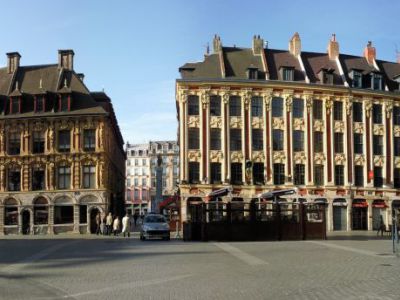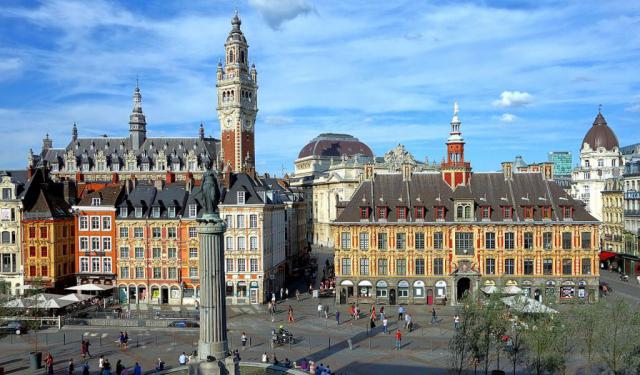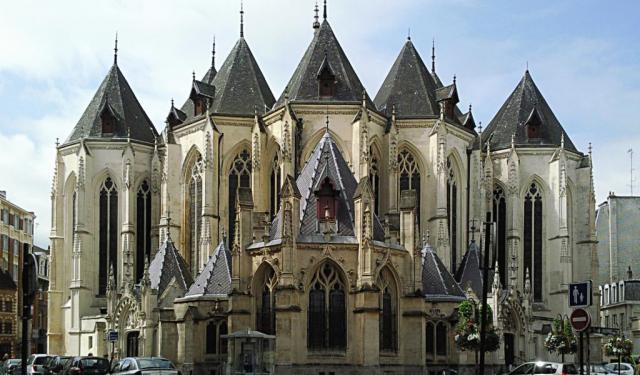Le Rang du Beauregard (Beauregard Row), Lille
Beauregard Row (Le Rang du Beauregard) is an impressive example of 17th-century French architecture located on Theater Square (Place du Théâtre) in Lille and has been a protected historic monument since 1966. Constructed from 1685 to 1687 by contractor Simon Vollant based on designs by architect Julien Destrée, it consists of a line of 14 two-bay houses. These houses replaced earlier wooden structures that had been there since 1551. In 1674, local authorities mandated that new buildings must match the style of nearby structures, including the Old Stock Exchange, leading to a design featuring three floors and an attic.
Similar to the Old Stock Exchange, the base of the building features sandstone arches, above which are three stories made of stone and brick topped with a mansard roof. The design of the façade, with its simple lines and subtle color and pattern choices, blends traditional French classical styles introduced after Lille was taken over by Louis XIV in 1667 with local Flemish influences, creating a unique Franco-Lille style.
The area got its name, Beauregard, from a viewing platform built by the Duke of Burgundy, Philippe Le Bon, in 1425, which stood across from the site until it was taken down in 1651. There are differing stories about how the name Beauregard came to be, with the most accepted theory being that the term "belvedere" might not have been commonly used to mean 'beauregard' during the 15th century.
On the right side of the façade, you can still see about a dozen cannonballs embedded in the wall. These are relics from the 1792 siege of Lille when over 30,000 cannonballs were fired at the city. One notable cannonball, which struck the Morel brewery, has been humorously painted pink and shaped to look like a breast.
Similar to the Old Stock Exchange, the base of the building features sandstone arches, above which are three stories made of stone and brick topped with a mansard roof. The design of the façade, with its simple lines and subtle color and pattern choices, blends traditional French classical styles introduced after Lille was taken over by Louis XIV in 1667 with local Flemish influences, creating a unique Franco-Lille style.
The area got its name, Beauregard, from a viewing platform built by the Duke of Burgundy, Philippe Le Bon, in 1425, which stood across from the site until it was taken down in 1651. There are differing stories about how the name Beauregard came to be, with the most accepted theory being that the term "belvedere" might not have been commonly used to mean 'beauregard' during the 15th century.
On the right side of the façade, you can still see about a dozen cannonballs embedded in the wall. These are relics from the 1792 siege of Lille when over 30,000 cannonballs were fired at the city. One notable cannonball, which struck the Morel brewery, has been humorously painted pink and shaped to look like a breast.
Want to visit this sight? Check out these Self-Guided Walking Tours in Lille. Alternatively, you can download the mobile app "GPSmyCity: Walks in 1K+ Cities" from Apple App Store or Google Play Store. The app turns your mobile device to a personal tour guide and it works offline, so no data plan is needed when traveling abroad.
Le Rang du Beauregard (Beauregard Row) on Map
Sight Name: Le Rang du Beauregard (Beauregard Row)
Sight Location: Lille, France (See walking tours in Lille)
Sight Type: Attraction/Landmark
Guide(s) Containing This Sight:
Sight Location: Lille, France (See walking tours in Lille)
Sight Type: Attraction/Landmark
Guide(s) Containing This Sight:
Walking Tours in Lille, France
Create Your Own Walk in Lille
Creating your own self-guided walk in Lille is easy and fun. Choose the city attractions that you want to see and a walk route map will be created just for you. You can even set your hotel as the start point of the walk.
Lille Introduction Walking Tour
Nicknamed in France the "Capital of Flanders", Lille and its surroundings belong to the historical region of Romance Flanders. Legend has it that in 620 AD, Salvaert, Prince of Dijon, passed through the region with his pregnant wife when he was attacked and killed by the local lord Phinaert The Giant. Years later, his son Lyderic avenged his father by killing the Giant and founded the... view more
Tour Duration: 2 Hour(s)
Travel Distance: 4.0 Km or 2.5 Miles
Tour Duration: 2 Hour(s)
Travel Distance: 4.0 Km or 2.5 Miles
Lille's Historical Buildings Tour
Historically, Lille's architecture differs from that of other French cities. Prior to being invaded by Louis XIV in 1667, Lille was Flemish, which is evident in its red-brick and other structures, quite uncommon for the rest of France.
Among many things, Lille is reputed for its fabulous historic center, abounding in time-honored buildings, palaces, and churches, offering a great deal of... view more
Tour Duration: 2 Hour(s)
Travel Distance: 3.7 Km or 2.3 Miles
Among many things, Lille is reputed for its fabulous historic center, abounding in time-honored buildings, palaces, and churches, offering a great deal of... view more
Tour Duration: 2 Hour(s)
Travel Distance: 3.7 Km or 2.3 Miles





